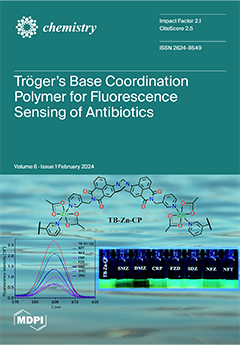A new method for the synthesis of azido-propargyloxy derivatives of 1,3,5-triazine has been developed utilizing the nitrosation of hydrazyno-1,3,5-triazines. New hydrazines (2-hydrazino-4,6-bis(propargyloxy)-1,3,5-triazine and 2,4-dihydrazino-6-propargyloxy-1,3,5-triazine) were synthesized and characterized via FTIR, NMR spectroscopy and elemental analysis. The hyperbranched polymers with azide (diazide monomer) and
[...] Read more.
A new method for the synthesis of azido-propargyloxy derivatives of 1,3,5-triazine has been developed utilizing the nitrosation of hydrazyno-1,3,5-triazines. New hydrazines (2-hydrazino-4,6-bis(propargyloxy)-1,3,5-triazine and 2,4-dihydrazino-6-propargyloxy-1,3,5-triazine) were synthesized and characterized via FTIR, NMR spectroscopy and elemental analysis. The hyperbranched polymers with azide (diazide monomer) and propargyloxy terminal groups were obtained via the azide-alkyne polycycloaddition reaction of diazide and monoazide AB
2-type monomers. The antibacterial activity against
Escherichia coli bacteria of 2,4,6-trispropargyloxy-1,3,5-triazine, 2-azido-4,6-bispropargyloxy-1,3,5-triazine, and 2,4-diazido-6-propargyloxy-1,3,5-triazine and their hyperbranched polymers was studied. Only 2,4-diazido-6-propargyloxy-1,3,5-triazine has weak antibacterial activity in comparison with ampicillin. The cytotoxicity of these compounds against M-HeLa, FetMSC, and Vero cell lines was also studied. 2,4,6-trispropargyloxy-1,3,5-triazine does not show any cytotoxic effect (IC
50 ≥ 280 µM). It was shown that the presence of an azide group in the compound directly affects the cytotoxic effect. Hyperbranched polymers have a less cytotoxic effect against M-HeLa (IC
50 > 100) in comparison with monomers (IC
50 = 90–99 µM). This makes it possible to use these polymers as the basis for biocompatible materials in biomedical applications.
Full article





